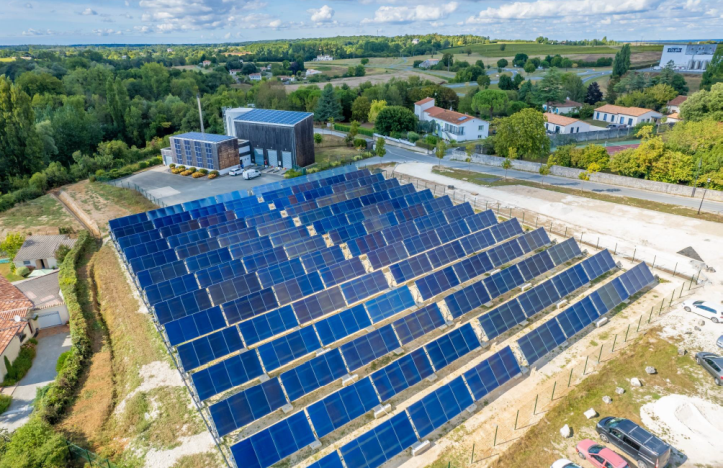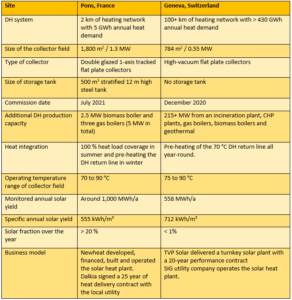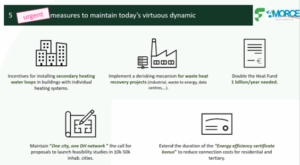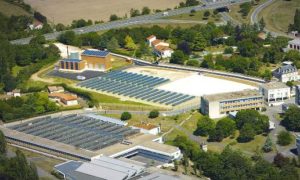Promising results from innovative solar district heating plants
February 27, 2023
In a webinar in mid-February, AMORCE, the French district heating association, described the successes of the French district heating sector and its growth strategy. It is a small sector covering only 5 % of the total heat demand – but is already decarbonised to a great extent. With more than 60 % renewable energy and waste heat, French DH has reduced its CO2 content by half over the past decade. AMORCE identified around 300 DH systems and wants the number of connected buildings to triple by 2030. Solar heat could play a significant role with its good yields as the monitoring data from two innovative plants in the region shows. You can find the recording of the webinar Renewable Heat versus Energy Crisis: a French way organised by Euro Heat & Power here.
Photo: Newheat
“Solar heat covers 100 % of the heat demand over the summer months when the biomass boiler would reach its technically minimal power”, said Nicolas Graveline, Head of International Development at Newheat, describing the performance of the 1,800 m2 district heating plant in the French town of Pons. The solar district heating plant guarantees low and stable prices for the users in Pons. The gas price risk has been reduced from 24 % to 8 %.
High yields from innovative solar district heating
In the year 2022 the solar plant contributed around 1,000 MWh to the district heating grid, which corresponds to a specific annual yield of 555 kWh/m2. Then results were quite close to what was simulated, as Graveline confirmed. The satisfying yield was possible because of a special type of collector field. The collectors are double glazed to increase efficiency and they are tracked along the rows in a single axis. This optimises the earnings on the limited ground area available. The tracking system can also prevent overheating by shading the collectors in summer.
The comparison table below shows another innovative solar district heating system, which has now been in operation for more than two years. It is a 784 m2 solar field consisting of special high-vacuum flat panels, which have supplied heat to Geneva’s district heating network since December 2020. The expected yield was exceeded by 5 to 10 % per year according to a press release sent out in February by the turnkey system supplier TVP Solar from Switzerland. The plant has produced 558 MWh annually on average since its start of operation, which corresponds to a specific annual yield of 712 kWh/m2.

Technical and performance data from two innovative district heating plants Source: Newheat / TVP Solar

Five urgent actions needed to triple the DH-connected buildings by 2030 Source: AMORCE
190 feasibility studies for new district heating grids
AMORCE used the webinar to list the urgent actions necessary to achieve a tripling of DH-connected buildings in France(see graphic above). That there is high interest in district heating on the municipality level is shown by the fact that 190 cities have already applied to the “One City, One DH network” call from Ademe, the French Energy Agency. AMORCE called for an estimated EUR 25 billion of investment by 2030 to achieve the identified goals. This seems small compared to the EUR 24 billion spent on the French tariff-shield on oil, electricity and gas in 2022, as Graveline emphasised during the webinar.
The money should be spent on incentivising the installation of central hot water systems in buildings as half of the French households heat their hot water with decentralised boilers. Other urgent actions are the doubling of the budget of the Heat Fund from EUR 520 million in 2022 to EUR 1 billion per year and the continuation of the “One city, one DH network”. Here, towns and cities with 10,000 to 50,000 inhabitants can apply for a feasibility study.
Tips and tricks for solar district heat planning
Another important input during the webinar came from Graveline when he listed three tips for solar district heating project development:
- Contractual: Lowering return temperatures is essential for the competitiveness of solar thermal. It is necessary to have a commitment from the DH operator in the heat purchase agreement.
- Technical: The heat demand in summer must be precisely assessed over several years and future energy saving actions must be taken into account to avoid oversizing the collector field.
- Relations: Good coordination with the DH operator is imperative, as the solar thermal plant and the other heat producers are a single system.
Websites of organisations mentioned in this news article:
Newheat: https://newheat.com/en/
TVP Solar: https://www.tvpsolar.com/
AMORCE: https://amorce.asso.fr/
EURO Heat & Power: https://www.euroheat.org/


